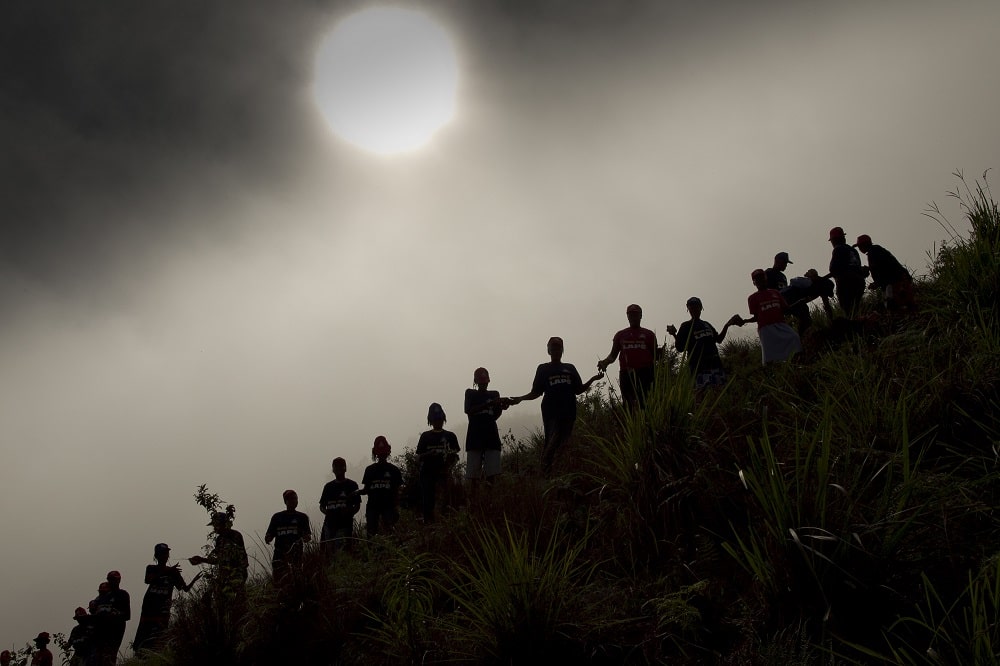Policy Brief and Key Messages for the 2022 Global Platform for Disaster Risk Reduction
Disaster Displacement and Disaster Risk Reduction to inform the Global Platform for Disaster Risk Reduction, Bali, Indonesia, 23-28 May 2022
Disasters affect people in different ways. One of them is displacement…
Millions of people are displaced in the context of disasters around the world, every year. In 2020 alone, 30.7 million new displacements were related to disasters, according to estimates by the Internal Displacement Monitoring Centre. Disaster displacement is multi-causal and driven by political, social, demographic, and environmental factors, including land degradation and unsustainable urbanization, among others. It occurs in the context of earthquakes and other geophysical hazards or is linked to extreme weather events, such as floods, storms and drought. Weather-related events were responsible for 98 per cent of all disaster displacement recorded in 2020.
The adverse effects of climate change are already increasing the frequency and intensity of weather-related hazards and undermining resilience. Climate change has contributed to almost a doubling of disaster events over the past two decades. As more people become exposed and are vulnerable to the impacts of such hazards, disaster displacement risk is likely to continue to increase. The Intergovernmental Panel on Climate Change (IPCC) projects human mobility patterns will change in response to extreme weather events and climate variability, including slow-onset events and processes such as drought and sea level rise. The 2022 IPCC Working Group II Contribution to the Sixth Assessment Report has “high confidence” that, “in the mid- to long-term, displacement will increase with intensification of heavy precipitation and associated flooding, tropical cyclones, drought and, increasingly, sea level rise”.
…which has devastating impacts on individuals and communities, especially the most vulnerable.
Moving away from risk areas can save lives. Pre-emptive evacuations are therefore a key component of disaster management. Population movements, however, need to be well-managed. Disaster displacement can have devastating social, economic, health and psychological impacts on individuals and communities, and affect the effective enjoyment of their human rights. Poorly anticipated, prepared for and managed displacement and its related impacts exacerbate pre-existing conditions of vulnerability, severely affecting children, women, older persons, persons with disabilities, indigenous peoples, traditional communities and people already marginalized. The needs and conditions of displaced persons may also be compounded by other factors such as the COVID-19 pandemic, food insecurity and increasing water scarcity.
Disaster displacement raises multiple protection concerns, undermines development gains, affects human rights and human security, across the globe. Disproportionate impacts are often borne more strongly by least developed countries (LDCs) and small island developing states (SIDS).
Incorporating displacement into national DRR targets and indicators to measure progress in implementing the Sendai Framework and aligning them with sustainable development and climate change planning are critical steps to prevent disaster displacement.
– Prof. Walter Kaelin, Envoy of the Chair of PDD
Key messages and proposed commitments for the Global Platform for DRR 2022
Member States and other stakeholders are encouraged to use their official statements as well as interventions in relevant plenary sessions such as high-level dialogues and thematic sessions or side events to promote these key messages for inclusion in the outcome documents.
Disasters affect people in many ways. Disaster displacement is one of them. States and other stakeholders should invest in disaster risk reduction, assess potential disaster displacement and prepare for movement in a way that minimizes associated risk.
These efforts should be coherent with wider climate action, human mobility, human rights, humanitarian and development efforts to strengthen the resilience and adaptive capacity of people at risk of displacement, address the protection needs of displaced people and achieve durable solutions to displacement.
States and other stakeholders are called upon to:
- Include provisions to address disaster displacement and other forms of human mobility in a coherent way in local, national and regional DRR policies and strategies.
- Work across silos and strengthen governance to foster the effective and coherent implementation of these policies and strategies in line with relevant global, regional and national policy frameworks and strategies on climate change action, development, humanitarian assistance and protection, human rights, migration management and refugee protection, among others.
- Strengthen efforts to understand risks related to disaster displacement, collect disaggregated displacement data, and use such information when reporting on and monitoring implementation of progress on DRR, and when developing contingency, preparedness, response and recovery plans.
- Build the capacity of local, national and regional stakeholders to address disaster displacement through the application of effective practices and existing learning, and ensure the allocation of funding, including at the local level.
- Ensure the inclusion and meaningful participation of people and groups displaced or at risk of displacement as well as host communities in DRR planning and response, with due attention to age, gender and diversity considerations.
Document to consult
The PDD Secretariat has prepared a non-exhaustive list of key publications on disaster displacement in collaboration with the PDD Advisory Committee. They will allow you to familiarize yourself with the latest publications on disaster displacement, bringing in relevant perspectives from climate change, disaster risk reduction (DRR) and other relevant disciplines.
Cover photo: © UNDP
Download the Key Messages
 Loading...
Loading...
Find out more about
Download the Event Flyer
